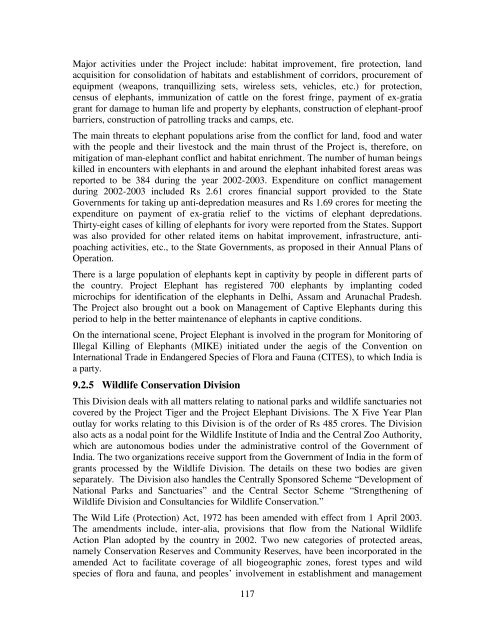Wildlife and Nature Conservation - Centre for Ecological Sciences
Wildlife and Nature Conservation - Centre for Ecological Sciences
Wildlife and Nature Conservation - Centre for Ecological Sciences
You also want an ePaper? Increase the reach of your titles
YUMPU automatically turns print PDFs into web optimized ePapers that Google loves.
Major activities under the Project include: habitat improvement, fire protection, l<strong>and</strong>acquisition <strong>for</strong> consolidation of habitats <strong>and</strong> establishment of corridors, procurement ofequipment (weapons, tranquillizing sets, wireless sets, vehicles, etc.) <strong>for</strong> protection,census of elephants, immunization of cattle on the <strong>for</strong>est fringe, payment of ex-gratiagrant <strong>for</strong> damage to human life <strong>and</strong> property by elephants, construction of elephant-proofbarriers, construction of patrolling tracks <strong>and</strong> camps, etc.The main threats to elephant populations arise from the conflict <strong>for</strong> l<strong>and</strong>, food <strong>and</strong> waterwith the people <strong>and</strong> their livestock <strong>and</strong> the main thrust of the Project is, there<strong>for</strong>e, onmitigation of man-elephant conflict <strong>and</strong> habitat enrichment. The number of human beingskilled in encounters with elephants in <strong>and</strong> around the elephant inhabited <strong>for</strong>est areas wasreported to be 384 during the year 2002-2003. Expenditure on conflict managementduring 2002-2003 included Rs 2.61 crores financial support provided to the StateGovernments <strong>for</strong> taking up anti-depredation measures <strong>and</strong> Rs 1.69 crores <strong>for</strong> meeting theexpenditure on payment of ex-gratia relief to the victims of elephant depredations.Thirty-eight cases of killing of elephants <strong>for</strong> ivory were reported from the States. Supportwas also provided <strong>for</strong> other related items on habitat improvement, infrastructure, antipoachingactivities, etc., to the State Governments, as proposed in their Annual Plans ofOperation.There is a large population of elephants kept in captivity by people in different parts ofthe country. Project Elephant has registered 700 elephants by implanting codedmicrochips <strong>for</strong> identification of the elephants in Delhi, Assam <strong>and</strong> Arunachal Pradesh.The Project also brought out a book on Management of Captive Elephants during thisperiod to help in the better maintenance of elephants in captive conditions.On the international scene, Project Elephant is involved in the program <strong>for</strong> Monitoring ofIllegal Killing of Elephants (MIKE) initiated under the aegis of the Convention onInternational Trade in Endangered Species of Flora <strong>and</strong> Fauna (CITES), to which India isa party.9.2.5 <strong>Wildlife</strong> <strong>Conservation</strong> DivisionThis Division deals with all matters relating to national parks <strong>and</strong> wildlife sanctuaries notcovered by the Project Tiger <strong>and</strong> the Project Elephant Divisions. The X Five Year Planoutlay <strong>for</strong> works relating to this Division is of the order of Rs 485 crores. The Divisionalso acts as a nodal point <strong>for</strong> the <strong>Wildlife</strong> Institute of India <strong>and</strong> the Central Zoo Authority,which are autonomous bodies under the administrative control of the Government ofIndia. The two organizations receive support from the Government of India in the <strong>for</strong>m ofgrants processed by the <strong>Wildlife</strong> Division. The details on these two bodies are givenseparately. The Division also h<strong>and</strong>les the Centrally Sponsored Scheme “Development ofNational Parks <strong>and</strong> Sanctuaries” <strong>and</strong> the Central Sector Scheme “Strengthening of<strong>Wildlife</strong> Division <strong>and</strong> Consultancies <strong>for</strong> <strong>Wildlife</strong> <strong>Conservation</strong>.”The Wild Life (Protection) Act, 1972 has been amended with effect from 1 April 2003.The amendments include, inter-alia, provisions that flow from the National <strong>Wildlife</strong>Action Plan adopted by the country in 2002. Two new categories of protected areas,namely <strong>Conservation</strong> Reserves <strong>and</strong> Community Reserves, have been incorporated in theamended Act to facilitate coverage of all biogeographic zones, <strong>for</strong>est types <strong>and</strong> wildspecies of flora <strong>and</strong> fauna, <strong>and</strong> peoples’ involvement in establishment <strong>and</strong> management117
















